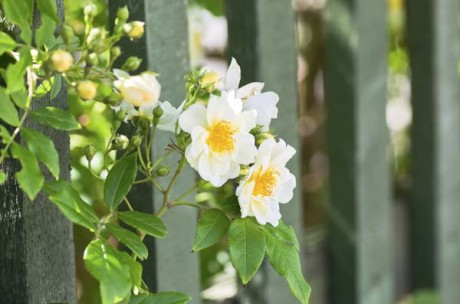Artful entrances
Create a unique, welcoming gate to your garden
By Katie Lamar JacksonIn addition to keeping out the riff-raff, garden gates can be a welcoming element of art. A garden gate may provide a line of view into a garden or serve as a transition, and can be the focal point of your garden or landscape. It can be as complicated or simple as you like, ranging from two sentinel posts with no real gate to a roofed pergola and a bench for relaxing.
Choosing one for your needs
A garden gate needs to be functional as well as beautiful. Ask yourself: Does the gate need to keep animals — four-legged, three-legged or even two-legged — in or out? Does it need to be lockable? Or is its function more art than utility? Could it simply be an open arbor that defines an entryway, or does it need to provide a screen of privacy? Does it need to match an existing fence or landscape design? Are there neighborhood regulations that may dictate your style choices?
Siting it
Once you have an idea of the kind of gate you want, figure out your site. A good idea is to take pictures of your garden or landscape from all sides and angles, including views from the house where the gate might be visible. Try black and white photos — they can help you spot assets and flaws in the location without the distraction of color.
Drawings and photos
Once you have picked your spot, sketch a picture of your dream gate adding any details you may want, such as whimsical touches of lattice, stained glass, woodwork, metal embellishments or paint. And think about what you want to plant around the gate, such as climbing roses or other vines or shrubs. If you don’t draw, collect photos of garden gates from magazines and books.
Materials
Garden gates can be made of almost anything, from bamboo to metal, wood to PVC or chicken wire (though it may take a special creative flair to make the chicken wire and PVC aesthetically pleasing) to simply an airy entryway with side posts but no real gate at all.
Some people use recycled materials or pieces of old barn wood for their gates, or reuse antique wood or metal gates found at yard sales or antique shops. Others have local wood or metal artists create one-of-a-kind gates. Still others take the do-it-yourself route and build their own using pre-packaged garden gate plans or their own design-build talents. You’ll want to make sure hardware (hinges and latches) matches your gate’s design and support.
Dimensions
Generally, a garden gate should be at least 3 feet wide, and up to 4 feet in width. If you want a wider gate space, consider putting in a double-sided gate and definitely plan to provide extra support from the gate posts.
Gate installation
Gate posts should be sturdy, straight and plumb and should be sunk at least 2 feet into the ground — 3 feet for wider or heavier gates — and perhaps even reinforced with concrete footings. Use treated lumber if you are using wooden posts so they won’t rot or be eaten by termites
-
Share this story:




